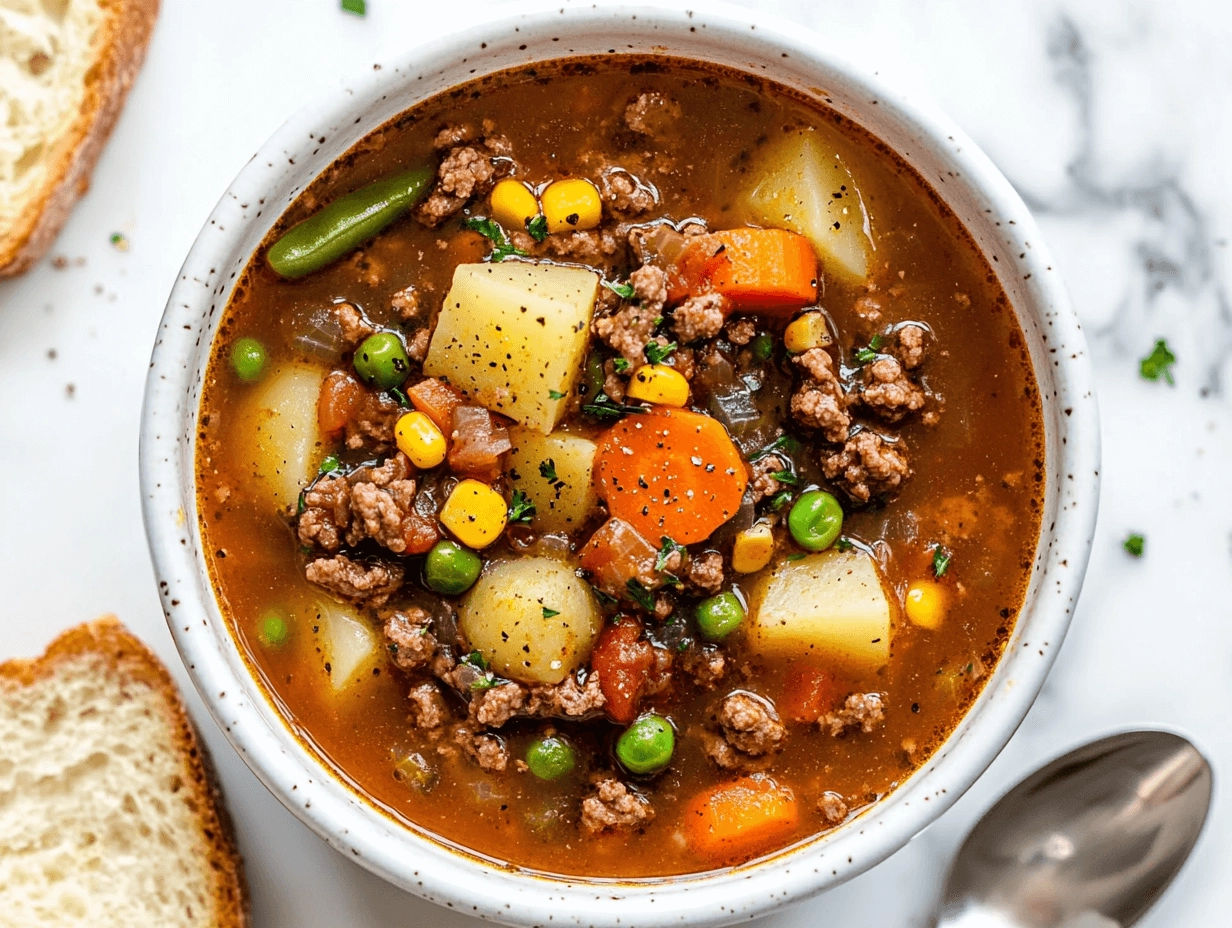Pregnancy is a time of joy, but gestational diabetes can add stress. You don’t have to feel overwhelmed. With healthy recipes, you can take control of your health.
Gestational diabetes affects insulin and blood sugar during pregnancy. By choosing the right dinner recipes, you can improve your health. These meals are packed with nutrients and help manage blood sugar.
Every meal is a chance to feed you and your baby well. These dinner recipes are made to keep your blood sugar stable. They also give you the nutrients you need, making your pregnancy better.
Table of Contents
Discover more delicious recipes and ideas by visiting our homepage!
Understanding Gestational Diabetes and Diet
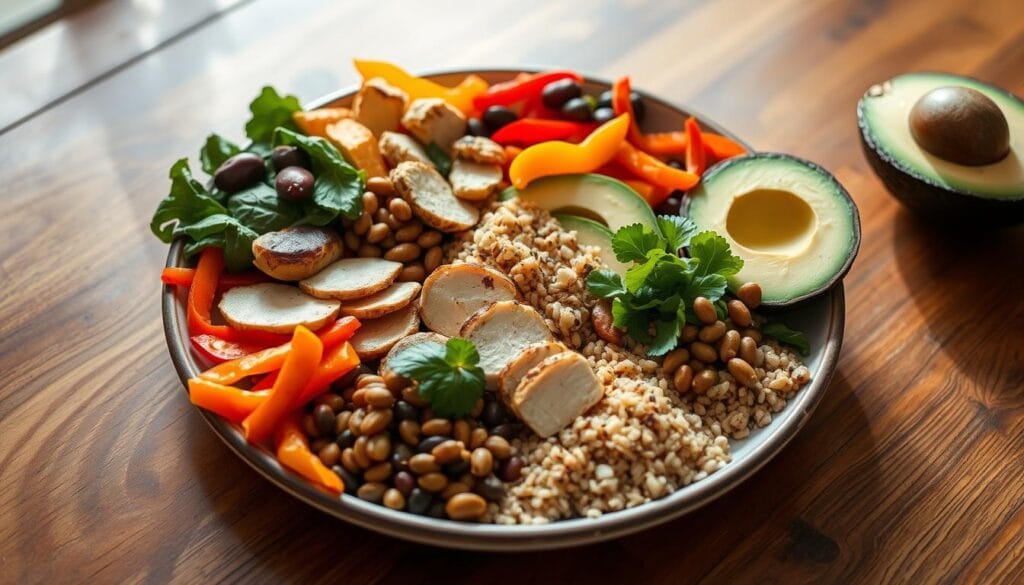
Gestational diabetes is a condition that affects how you eat during pregnancy. It happens when your body can’t make enough insulin. This leads to high blood sugar levels, which can harm both you and your baby.
Key characteristics of gestational diabetes include:
- Typically develops in the second half of pregnancy
- Affects approximately 7% of all pregnancies
- Can resolve after childbirth
- Increases risk of future type 2 diabetes
Your diet is key in managing blood sugar levels with gestational diabetes. You need to eat in a way that keeps your blood sugar stable. This means choosing the right foods and planning your meals carefully.
| Dietary Recommendation | Impact on Blood Sugar |
|---|---|
| Small, frequent meals | Prevents dramatic blood sugar fluctuations |
| Low glycemic index foods | Reduces sudden glucose spikes |
| Balanced macronutrients | Supports steady energy and blood sugar control |
It’s important to work with healthcare providers and nutritionists to create a diet plan. They can help you make a plan that’s good for you and your baby.
By understanding gestational diabetes and using the right nutrition, you can manage it well. This helps ensure a healthy pregnancy for you and your baby.
Nutritional Guidelines for Gestational Diabetes
Managing your diet during pregnancy with gestational diabetes is key. Diabetic meal plans help keep your blood sugar levels healthy. They also support your baby’s growth. Knowing the right nutrients is important for low-glycemic meals that benefit both you and your baby.
Good nutrition during pregnancy means making smart food choices. Your body needs certain nutrients for your baby’s growth and to control blood sugar.
Macronutrient Balance
It’s important to balance macronutrients when managing gestational diabetes. Your diet should include:
- Protein: 71 grams per day
- Calcium: 1,000 milligrams
- Vitamin D: 600 international units
- Folic acid: 600-1,000 micrograms
Portion Control Guidelines
| Food Group | Recommended Serving |
|---|---|
| Vegetables | 2-4 cups daily |
| Protein | 3-4 oz per meal |
| Carbohydrates | 45-60 grams per meal |
Meal Timing Recommendations
Eating every 4-5 hours helps keep your blood sugar stable. Here are tips for diabetic meal plans:
- Eat small, frequent meals
- Include protein with each meal
- Choose low-glycemic meals
- Stay hydrated
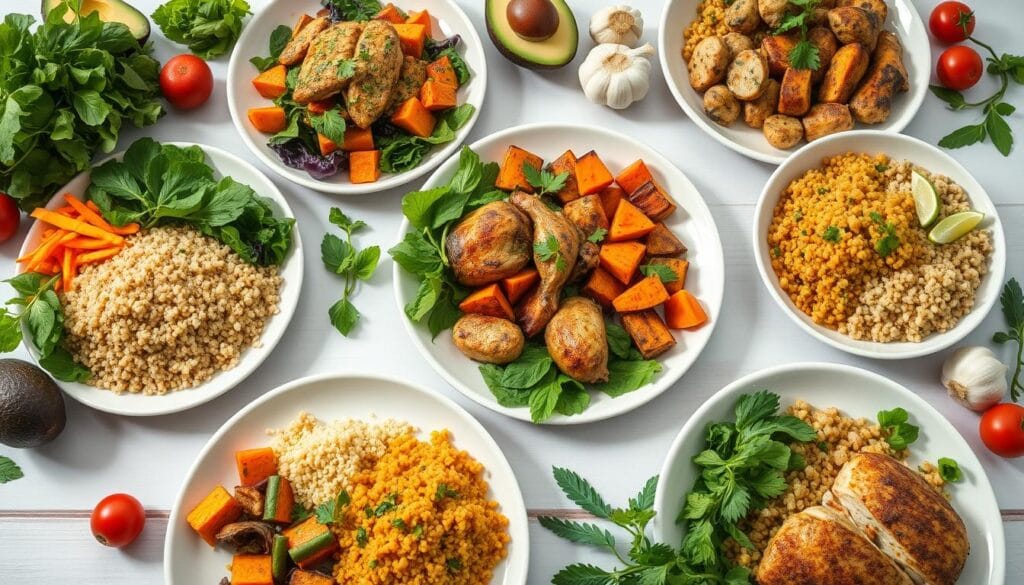
Consult with your healthcare provider to develop a personalized nutrition plan that meets your specific needs during pregnancy.
The Diabetes Plate Method
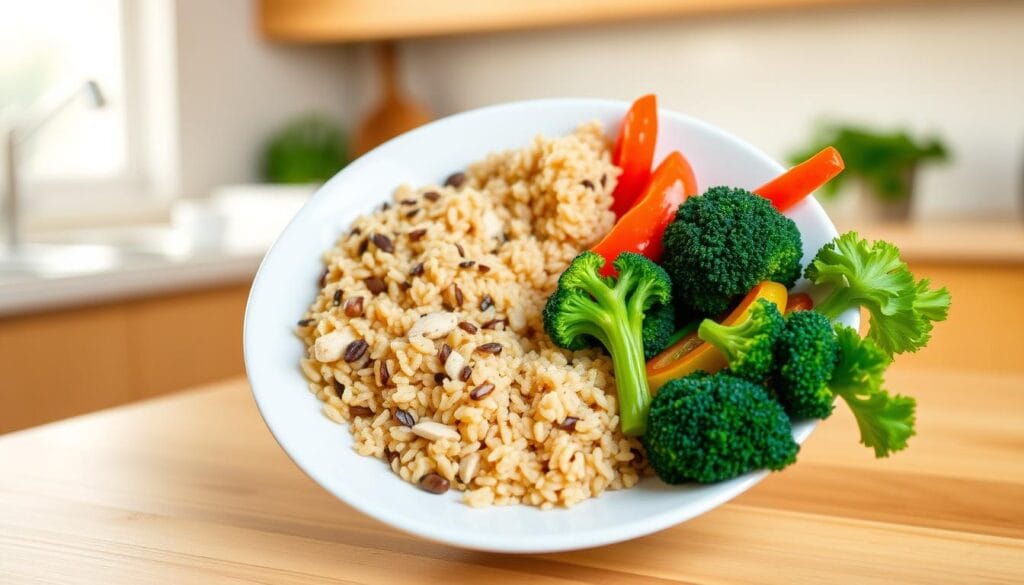
Managing blood sugar during pregnancy needs a smart meal plan. The Diabetes Plate Method is a simple way to make healthy meals. It helps control blood sugar and meets your nutritional needs.
This method makes meal prep easy by dividing your plate into parts:
- 50% non-starchy vegetables
- 25% lean protein
- 25% complex carbohydrates
Your 9-inch plate is a key tool for managing blood sugar. Non-starchy veggies are full of nutrients but don’t raise blood sugar much. Lean proteins help the baby grow and keep blood sugar stable. Complex carbs give energy without causing big blood sugar jumps.
| Plate Section | Food Examples | Nutritional Benefits |
|---|---|---|
| Vegetables (50%) | Spinach, broccoli, cauliflower | High fiber, low carbohydrate |
| Protein (25%) | Grilled chicken, tofu, fish | Supports muscle growth, stabilizes blood sugar |
| Carbohydrates (25%) | Quinoa, sweet potato, brown rice | Controlled energy release |
Using the Diabetes Plate Method makes meal planning simple. Your plate becomes a roadmap to balanced nutrition that supports both you and your baby.
Don’t forget to drink plenty of water or low-calorie drinks. Always talk to your healthcare provider for diet advice that’s right for you.
Essential Kitchen Preparations
Getting your kitchen ready for prenatal meal prep is key for managing gestational diabetes. It helps ensure you eat healthily during pregnancy. A tidy kitchen makes cooking nutritious meals easier and faster.
Required Ingredients for Prenatal Meal Prep
Start by stocking your pantry with the right ingredients for blood sugar-friendly meals. Choose whole, nutrient-rich foods that meet your pregnancy needs.
- Whole grains like brown rice and quinoa
- Lean proteins (chicken, fish, tofu)
- Fresh vegetables and low-glycemic fruits
- Healthy fats (olive oil, avocados, nuts)
- Low-fat dairy or dairy alternatives
Essential Cooking Tools and Equipment
Invest in kitchen tools that simplify prenatal meal prep. These items help you make nutritious meals quickly and with less stress.
| Tool | Purpose |
|---|---|
| Meal prep containers | Portion control and easy storage |
| Digital food scale | Accurate portion measurement |
| Instant Pot or slow cooker | Easy batch cooking |
| Vegetable spiralizer | Create low-carb vegetable alternatives |
Smart Meal Prep Strategies
Develop a consistent meal prep routine to manage gestational diabetes well. Batch cooking and advanced prep save time and reduce stress.
- Plan meals for the entire week
- Prep ingredients in advance
- Use portion-controlled containers
- Freeze extra meals for quick access
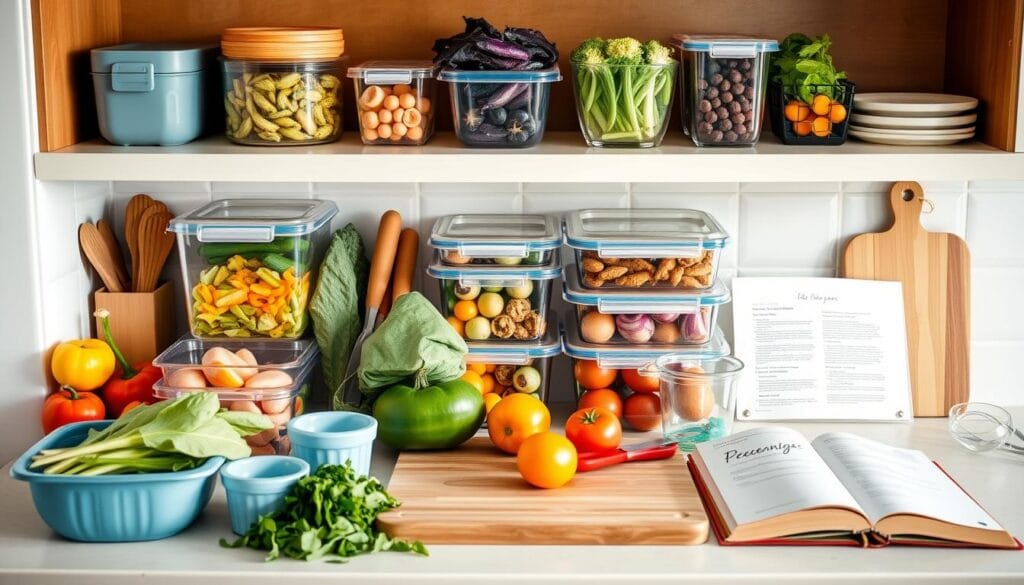
Effective prenatal meal prep creates a supportive environment. It makes healthy eating convenient and enjoyable during your pregnancy.
Gestational Diabetes Dinner Recipes
Finding dinner recipes for gestational diabetes can be tough. What you eat for dinner is key to managing your blood sugar while pregnant. These dishes are made to be nutritious and keep your blood sugar stable.
When making dinner recipes for gestational diabetes, aim for balanced meals. Mix protein, complex carbs, and veggies. The goal is to make meals that meet your nutritional needs without raising your blood sugar too high.
- Choose lean proteins like chicken, fish, and tofu
- Include low-glycemic vegetables
- Select whole grains in moderation
- Incorporate healthy fats
Your meal plan should focus on foods rich in nutrients that help control blood sugar. Portion control and balanced macronutrients are essential for managing gestational diabetes through diet.
| Nutrient | Recommended Amount | Benefits |
|---|---|---|
| Protein | 60-75 grams daily | Stabilizes blood sugar |
| Fiber | 30 grams daily | Slows glucose absorption |
| Complex Carbs | 175-210 grams daily | Provides steady energy |
Remember, every pregnancy is different. Talk to your healthcare provider to tailor these dinner recipes to your needs. Your aim is to keep your blood sugar stable while feeding yourself and your baby.
Blood Sugar-Friendly Protein Options
Managing pregnancy nutrition is key when you have gestational diabetes. Choosing the right protein sources is vital for keeping blood sugar stable. Your diet helps control blood glucose and supports your baby’s growth.
Lean proteins are a must in a gestational diabetes diet. They help keep blood sugar levels steady and provide important nutrients for you and your baby. Here are some good protein options:
- Chicken breast
- Turkey
- Fish (salmon, cod)
- Eggs
- Greek yogurt
- Tofu
- Legumes
Research shows that some proteins are better than others. Nuts like almonds and walnuts are great. A study found that walnut eaters were 50% less likely to get diabetes than those who didn’t eat them.
When cooking proteins, choose grilling, baking, or steaming. These methods keep nutrients in. Avoid frying, as it adds extra calories and can affect blood sugar.
Remember to control your portions. Aim for 3-4 ounces of protein at each meal. Pair it with complex carbs and veggies for balanced, blood sugar-friendly meals.
By picking the right proteins, you can meet your pregnancy nutrition needs and manage gestational diabetes well.
Smart Carbohydrate Choices
Choosing the right carbs during pregnancy can be tough, even for those with gestational diabetes. It’s key to pick smart carbs to keep blood sugar stable and support a healthy pregnancy.
Low-Glycemic Grains
For low-glycemic meals, go for whole grains that help control blood sugar. Here are some top picks:
- Quinoa
- Barley
- Millet
- Steel-cut oats
- Sorghum
Starchy Vegetables
Adding starchy veggies to your diet can help keep blood sugar balanced. Here are some good choices:
| Vegetable | Glycemic Impact | Serving Size |
|---|---|---|
| Sweet Potatoes | Low-Moderate | 1/2 cup |
| Green Peas | Low | 1/4 cup |
| Butternut Squash | Low-Moderate | 1/3 cup |
Portion Guidelines
It’s important to control carb portions for good blood sugar management. Follow these tips:
- Limit total carb intake to 30-45 grams per meal
- Choose complex carbs with lots of fiber
- Pair carbs with lean proteins
- Watch how your body reacts to different carbs
By picking low-glycemic meals and controlling portions, you can manage blood sugar in pregnancy. Remember, everyone reacts differently to carbs. So, work with your healthcare provider to create a diet plan that’s right for you.
Vegetable Combinations and Preparations
Vegetables are full of nutrients for pregnant women with gestational diabetes. You can make tasty, healthy meals from simple veggies. These meals help meet your pregnancy nutrition needs.
Here are some tips for cooking veggies during pregnancy:
- Roasting brings out natural sweetness without adding calories
- Steaming preserves maximum nutrient content
- Stir-frying allows quick cooking with minimal oil
- Raw vegetable salads provide maximum nutritional benefits
Make colorful veggie mixes to get more nutrients. Dark leafy greens, cruciferous veggies, and bright produce are great for pregnant women with gestational diabetes.
| Vegetable Type | Nutritional Benefits | Best Preparation Method |
|---|---|---|
| Spinach | High in iron, folate | Steamed or lightly sautéed |
| Broccoli | Fiber, vitamin C | Roasted with minimal olive oil |
| Bell Peppers | Vitamin A, low glycemic | Raw or stir-fried |
Your veggie choices can help keep blood sugar stable and provide important nutrients. Try to eat a variety of veggies every day. This supports a healthy diet during pregnancy.
Healthy Fats and Seasonings
Managing your gestational diabetes diet means choosing the right healthy fats and seasonings. Knowing which fats are good for you can make meals tasty and healthy.
Nuts are great for pregnant women. Almonds, walnuts, and peanuts are full of nutrients. They help with your pregnancy nutrition needs. These foods offer:
- Low carbohydrate content
- High protein levels
- Heart-healthy omega-3 fatty acids
- Crucial minerals for fetal development
When picking healthy fats for your diet, choose ones that are full of nutrients. They make your meals satisfying and help keep your blood sugar stable.
| Fat Source | Nutritional Benefits | Serving Size |
|---|---|---|
| Avocado | Monounsaturated fats, fiber | 1/4 medium avocado |
| Extra Virgin Olive Oil | Anti-inflammatory properties | 1 tablespoon |
| Chia Seeds | Omega-3, protein | 1 ounce |
Try using herbs and spices to add flavor without affecting your blood sugar. Cinnamon, turmeric, and fresh herbs can make your meals exciting while helping your pregnancy nutrition goals.
Meal Planning and Prep Tips
Prenatal meal prep can change how you manage gestational diabetes. It’s about planning and preparing meals wisely. This makes cooking easier every day.
Good diabetic meal plans mean using your time well in the kitchen. With smart tips, you can make healthy meals. These meals are good for you and your baby.
Weekly Planning Strategies
Good prenatal meal prep starts with a weekly plan. Here are some tips:
- Make a meal schedule on Sunday
- Choose recipes with similar ingredients to reduce waste
- Prep protein and vegetable components in advance
- Use portion-controlled containers for easy tracking
Storage Solutions
Storing meals right is key for quality and safety. Get:
- Glass meal prep containers with tight-fitting lids
- Refrigerator thermometer to ensure correct temperatures
- Vacuum-sealed bags for longer-term ingredient storage
- Clearly labeled containers with preparation dates
Time-Saving Techniques
Make your diabetic meal plans quicker with these tips:
- Batch cook staple proteins like chicken and fish
- Utilize slow cookers and instant pots
- Chop vegetables in advance
- Freeze individual portions for quick meals
Remember, a bit of prep can cut down daily stress. It helps keep your blood sugar levels steady during pregnancy.
Managing Blood Sugar Levels
Managing blood sugar during pregnancy is key. It’s not just about what you eat. Knowing how to check and control your blood sugar is important. It helps keep you and your baby healthy.
Here are some ways to manage blood sugar levels:
- Regular blood glucose monitoring
- Consistent physical activity
- Stress management techniques
- Close collaboration with healthcare providers
Exercise is very important for blood sugar control. Try to walk for at least 30 minutes each day. Moderate exercise makes your body better at using insulin and keeps blood sugar stable.
| Activity Type | Weekly Recommendation | Blood Sugar Impact |
|---|---|---|
| Walking | 150 minutes moderate activity | Improves insulin sensitivity |
| Prenatal yoga | 2-3 sessions per week | Reduces stress, supports blood sugar regulation |
| Swimming | 30-45 minutes | Low-impact exercise with minimal risk |
Your healthcare provider can make a plan just for you. They’ll help you understand your blood sugar readings. They’ll also guide you on how to adjust your diet and lifestyle.
Stress can really affect your blood sugar. Try relaxation methods like deep breathing, meditation, or gentle stretching. These can help keep your blood sugar stable during your pregnancy.
Conclusion
Managing gestational diabetes doesn’t have to be hard. The dinner recipes you’ve found are a great way to keep your blood sugar stable. They help support your health during pregnancy.
Research shows that good meal planning can make a big difference. For example, the eMOM pilot study followed 42 people. It showed that the right diet can keep glucose levels just right. Your healthy recipes are more than food; they’re a way to take care of yourself and your baby.
Getting help from a dietitian who knows about gestational diabetes is important. They can make sure your meal plan fits your needs. By following these tips, you can manage your diabetes well and give your baby a strong start.
Start using these recipes, watch how you do, and keep in touch with your doctor. This time with gestational diabetes is a chance to learn healthy eating habits. These habits will help you and your child for years to come.
FAQ
What is gestational diabetes?
Gestational diabetes is a condition that happens during pregnancy, usually around the 24th week. It happens when your body can’t make enough insulin to control blood sugar. This can affect both mom and baby. It needs careful diet and medical watch during pregnancy.
What is a good dinner for gestational diabetes?
A good dinner for gestational diabetes should have lean protein, non-starchy veggies, and complex carbs. Try grilled chicken with roasted veggies and quinoa. Or baked salmon with sweet potato and steamed broccoli. A turkey and veggie stir-fry with brown rice is also good.
What is a meal plan for gestational diabetes?
A meal plan for gestational diabetes aims to keep blood sugar stable. It includes 3 moderate meals and 2-3 small snacks a day. Focus on low-glycemic foods, control portions, and balance proteins, complex carbs, and healthy fats.
Is pasta ok for gestational diabetes?
Whole grain pasta in small amounts is okay for gestational diabetes. Choose whole wheat or high-fiber pasta. Eat 1/2-3/4 cup and pair with lean protein and veggies to avoid blood sugar spikes.
Can I eat a burger with gestational diabetes?
You can have a burger with gestational diabetes by making smart choices. Use a whole grain bun or lettuce wrap. Choose lean meat like turkey or chicken. Add lots of veggies and avoid sugary toppings. Watch your portion size and have a side salad.
How many carbohydrates should I eat with gestational diabetes?
Women with gestational diabetes should aim for 30-45 grams of carbs per meal and 15-20 grams per snack. But, your needs may differ. Always work with a registered dietitian or healthcare provider to create a meal plan that’s right for you.
What foods should I avoid with gestational diabetes?
Stay away from foods high in simple sugars and refined carbs. Avoid sugary drinks, white bread, pastries, fruit juices, processed snacks, and foods with added sugars. Instead, eat whole foods, lean proteins, and lots of veggies.



